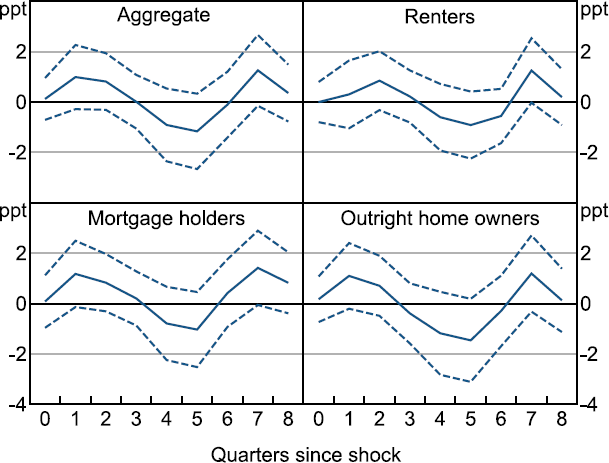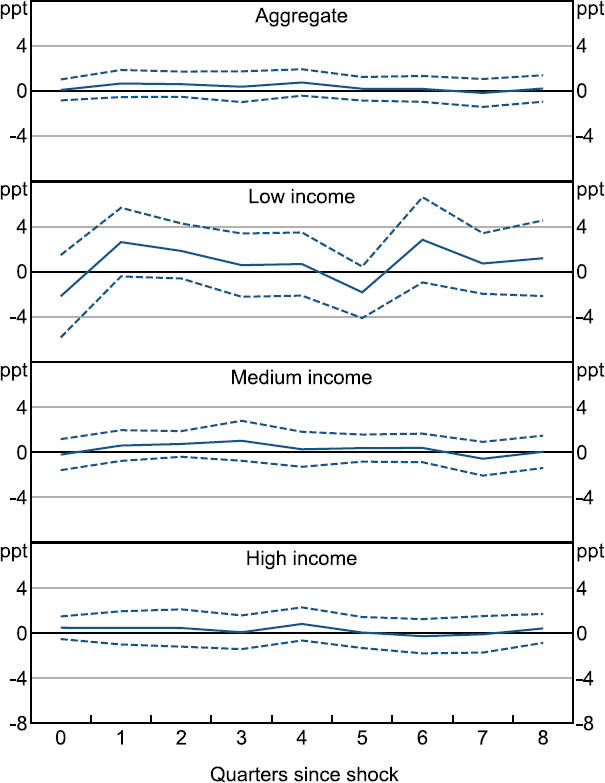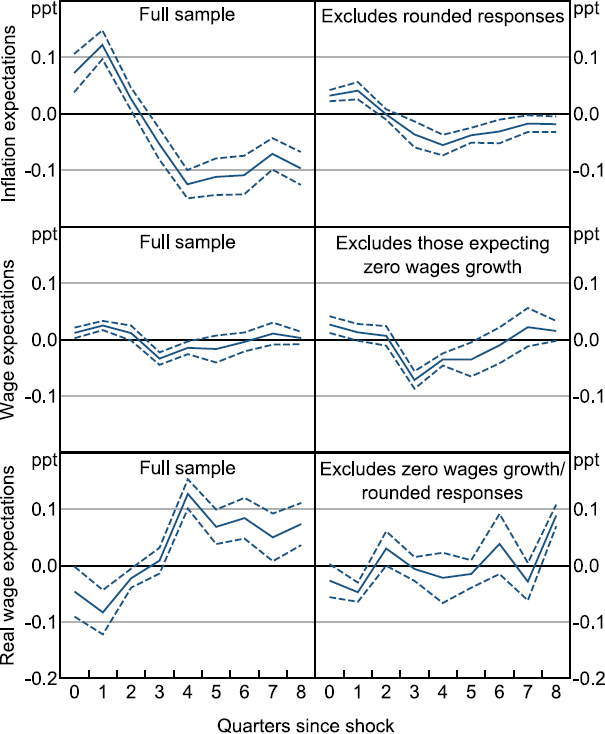RDP 2024-07: How Do Households Form Inflation and Wage Expectations? 5. Responsiveness of Expectations to Shocks
October 2024
- Download the Paper 1.59MB
The above results provide a number of stylised facts that suggest that inflation and wages expectations are formed somewhat differently. However, the findings are correlations, rather than causal. Moreover, they do not give us any indication of why they are formed differently.
One way to try address this is to examine how inflation and wages expectations respond to various economic shocks. As these shocks are exogenous, the findings should have a causal interpretation. Moreover, one explanation for the above findings is that supply shocks are an important driver of households' expectations, particularly their inflation expectations. Looking at the effects of supply shocks on wage and inflation expectations can help us explore this.
For this analysis we adopt a local projection regression of the following form:
where Et+h is the expectation measure h periods ahead. This is measured at the aggregate level, either across all respondents or as a microaggregate for a certain cohort. To improve estimation efficiency, we include a number of controls (inflation, GDP growth and the unemployment rate). To account for serial correlation, we include two lags of these controls, as well as two lags of the shock and left-hand side variables. We use robust standard errors. The findings are generally robust to using different lag lengths and excluding the macro controls (see Appendix A).
5.1 Expectations and monetary policy (demand) shocks
The first shock we explore is a monetary policy shock. This will essentially be a shock to aggregate demand, so standard theory would suggest that both inflation and wage expectations should fall in response to a contractionary shock.
As our monetary policy shock we use the measure outlined Beckers (2020). This is a Romer and Romer (2004)-style shock, constructed as divergences of the observed policy rate from the predictions of an estimated policy reaction function. The reaction function is a Taylor rule augmented with forecasts for economic conditions and several indicators of financial conditions. As such, it removes the anticipatory component of monetary policy by purging the changes in the policy rate of the central bank's systematic response to its own forecasts. We choose this measure as it has been shown to overcome the price puzzle. We also check robustness using high-frequency identified measures in Hambur and Haque (2024). In both cases shocks are only available for the pre-COVID-19 period.
Overall, we find very little evidence that monetary policy shocks affect households' inflation expectations in aggregate (Figure 8). Notwithstanding some volatility after around two years, inflation expectations do not appear to significantly move following a shock. This is slightly surprising given Beckers (2020) showed that these shocks do push down inflation. One explanation for this might be that expectations are well anchored, and households expect the effects of the shock to be fairly short-lived. This would be consistent with the findings in Coibion et al (2020), who find that monetary policy announcements have little effect on inflation expectations in a number of low-inflation economies. Another might be that expectations are somewhat backward looking and slow to update (consistent with our findings in Section 6), meaning expectations are slow to respond, particularly to a temporary policy shock.
As a further exercise we explore heterogeneity based on housing tenure. This is potentially interesting as we could imagine higher rates flow through to perceived costs for people with differing housing tenures quite differently. For example, even though it is not a component of the CPI, if home owners with a mortgage consider mortgage interest rates to be a component of the ‘things you buy’ (as asked by the survey), we might see expectations for this group rise after a contractionary shock. Similarly, if renters expect higher interest rates paid by their landlords to be passed onto their rents they might raise their expectations.[6] There is limited evidence of differing responses of different household types to monetary policy shocks. Despite some volatility, all show little to no change in expectations following a shock.[7]

Notes: Inflation expectations exclude rounded responses. Dashed lines indicate 90 per cent confidence intervals.
Sources: Authors' calculations; Melbourne Institute.
Turning to wage expectations, we again find very limited evidence of an aggregate effect (Figure 9). In part this is unsurprising, given the estimated response of actual wages, as embodied by the WPI, is not significant.
Again, it is interesting to explore heterogeneity in this result. A particular angle of interest is heterogeneity across income groups. Previous work has shown that employment income for lower income households tends to be more responsive to the economic cycle (e.g. Coates and Ballantyne 2022). As such, we might expect expectations for lower income households to be less responsive. At the same time, lower income households may be expected to be less attentive to future conditions as they may be constrained – off their intemporal Euler equations – meaning expectations for future outcomes are less important for current decisions. Overall though, we find very little evidence that wages expectations respond for any income group.

Notes: Wage expectations exclude those expecting zero wages growth. Low income defined as below $40,000, medium income as $40,000 to $100,000, and high income as above $100,000. Dashed lines indicate 90 per cent confidence intervals.
Sources: Authors' calculations; Melbourne Institute.
5.2 Expectations and oil price (supply) shocks
The second shock we explore is an oil supply shock. This is a standard supply shock that should push up inflation, but weaken economic activity. As such, if such shocks are important for households' inflation expectation formation it could help to explain the above negative association between inflation expectations and conditions.
The measure of oil supply shocks we consider is taken from Känzig (2021), which uses high-frequency changes in oil prices around OPEC announcements. We use this measure to instrument changes in domestic fuel prices in order to scale the effect to something interpretable for the Australian economy.
For this analysis we focus both on the preferred wage and inflation expectations, removing zero wages growth and rounded responses, respectively, and the full sample of responses, given it makes a moderate difference to the interpretation. We also construct a measure of real wage expectations (wage expectations less inflation expectations) to capture the perceived effect on real income, which may be better aligned to expectations for economic conditions compared to the nominal wage expectations in response to a supply shock.
Focusing first on the effect on inflation, we find that a 1 per cent supply-driven increase in the price of fuel pushes up inflation expectations by around 0.04 percentage points within the first couple of quarters removing the rounded responses (Figure 10). This is broadly in line with the fact that fuel prices make up around 4 per cent of the consumption basket. Focusing on the full sample of inflation expectations the effect is somewhat larger, at around 0.10 percentage points. For comparison, the actual effect on inflation is around 0.075 percentage points (Figure A1). So overall, the effects on inflation expectations are broadly in line with the actual effect.
That said, as discussed below in Section 6, only a moderate share of households appears to form their expectations using forward-looking information and the rate of learning from past data is quite slow, on average over time. So households' expectations are potentially a bit more responsive to oil price shocks than they are to the ‘average’ shock.
There is also some evidence that wage expectations increase following an oil price shock, before falling. This is somewhat surprising as WPI does not respond to an oil price shock (see Figure A1). The increase in wage expectations tends to be a bit smaller than the response of inflation. To see this more directly we can look at the effect on real wages. These tend to decline somewhat after the initial shock, particularly when focusing on the full sample, before rebounding.

Notes: All responses outside –50 to 50 per cent are trimmed. Dashed lines indicate 90 per cent confidence intervals.
Sources: Authors' calculations; Melbourne Institute.
Footnotes
This is similar to the cost channel of monetary policy. There is little evidence of positive pass-through of landlord interest cost to rents in Australia (Hambur, Twohig and Yadav forthcoming). [6]
We also explore differences across household income levels, and find no evidence of a response for high, low or middle income households. [7]